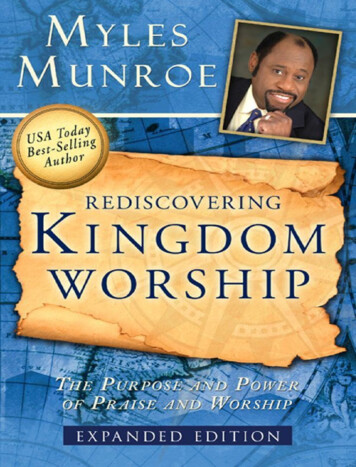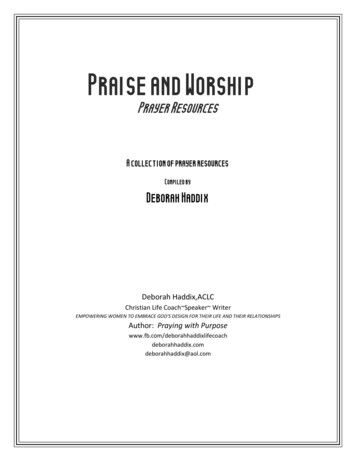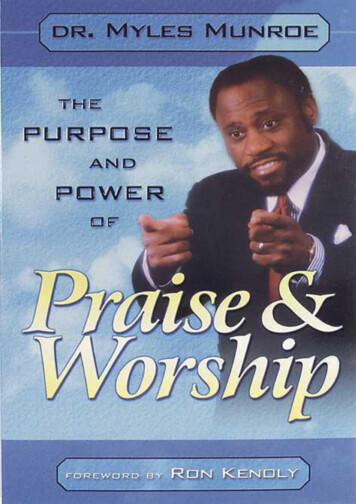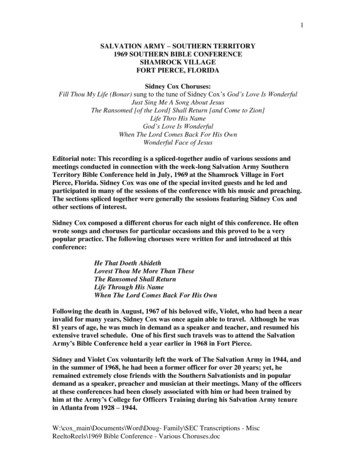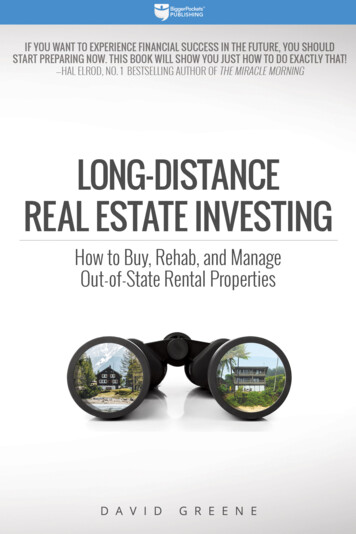
Transcription
Praise forLONG-DISTANCEREAL ESTATEINVESTING“I’ve been in real estate my entire adult life, and I have seen manydifferent systems and ideas on how to get rich in the business. David’ssystem is the first solid one I’ve seen that allows you to choose themarket that’s best for you and invest where it makes sense, not justwhere you happen to live and are comfortable. I recommend this bookto all my listeners on Real Estate Rockstars.”—Pat Hiban, New York Times best-selling author of6 Steps to 7 Figures: A Real Estate Agent’s Guide toBuilding Wealth and Creating Your Destiny and hostof the award-winning podcast Real Estate Rockstars“It is a common misperception in real estate investing that you shouldbuy only where you live. David Greene has put that myth to rest. Inthis book, he shows you the secrets to building your wealth throughreal estate. This is a must-read for investors who want to expand theirreal estate empire nationwide.”—David Osborn, best-selling authorof Wealth Can’t Wait
“David’s advice in this book was the catalyst I needed to finally lookoutside my own backyard for real estate deals. I tripled my rentalportfolio by purchasing out-of-state rental properties thanks to theadvice in this book. I wish I had read this a decade ago!”—Brandon Turner, real estate investor, podcast host,and author of The Book on Rental Property Investing“I’ve found the key to a successful day hinges on putting yourself ina position to succeed before the day starts. The same is true for yourfinancial life. David has found a way to allow anyone to invest in realestate wherever it makes sense to do so, rather than waiting for his orher specific market to be in an ideal state. If you want to experiencefinancial success in the future, you should start preparing now. Thisbook will show you how to do exactly that!”—Hal Elrod, number one best-selling authorof The Miracle Morning“The real beauty of David’s system is that the principles apply to scaling your real estate investing business across the board, whetheryou’re looking to pick up a few single-family rentals or acquire largemultifamily properties. He systematically disassembles the mythsand roadblocks of long-distance real estate investing and in their placeprovides the path to successfully investing anywhere, whether nearor far!”—Andrew Cushman, real estate investing expertand author on BiggerPockets.com
LONG-DISTANCEREAL ESTATEINVESTINGHOW TO BUY, REHAB, AND MANAGEOUT-OF-STATE RENTAL PROPERTIESD A V I DG R E E N E
This publication is protected under the U.S. Copyright Act of 1976 and all otherapplicable international, federal, state, and local laws, and all rights are reserved,including resale rights: You are not allowed to reproduce, transmit, or sell thisbook in part or in full without the written permission of the publisher.Limit of Liability: Please note that much of this publication is based on personalexperience and anecdotal evidence. Although the author and publisher have madeevery reasonable attempt to achieve complete accuracy of the content in thisbook, they make no representations or warranties with respect to the accuracyor completeness of the contents of this book and specifically disclaim any impliedwarranties of merchantability or fitness for a particular purpose. Your particularcircumstances may not be suited to the examples illustrated in this book; in fact,they likely will not be. You should use the information in this book at your ownrisk. Nothing in this book is intended to replace common sense or legal, accounting, or professional advice, and it is meant only to inform.Any trademarks, service marks, product names, and named features are assumedto be the property of their respective owners and are used only for reference. Noendorsement is implied when we use one of these terms.Long-Distance Real Estate InvestingDavid GreenePublished by BiggerPockets Publishing LLC, Denver, COCopyright 2017 by David Greene.All Rights Reserved.Publisher’s Cataloging-in-Publication dataNames: Greene, David M., author.Title: Long-Distance real estate investing : how to buy , rehab , and manage out-ofstate rental properties / David Greene.Description: Denver, CO: BiggerPockets Publishing, 2017Identifiers: ISBN 978-0-9975847-5-2 (pbk.) 978-0-9975847-6-9 (ebook) LCCN2017956004Subjects: LCSH Real estate investment--United States. Dwellings--Remodeling. Dwellings--Remodeling--Planning. Residential real estate--United States. House buying--United States. Rental housing--Management. Rental housing--Finance. Real estate management. BISAC BUSINESS & ECONOMICS / RealEstate / General BUSINESS & ECONOMICS / Personal Finance / InvestingClassification: LCC HD259 .G74 2017 DDC 332.63/243--dc23Published in the United States of America10 9 8 7 6 5 4 3 2 1
CONTENTSC H A P T E R 1: Why Invest Out of State? . . . . . . . . . . . . . . . . . . . . . . . 12Don’t Trust Your Gut . . . . . . . . . . . . . . . . . . . . . . . . . . . . . . . . . . . . .Disrupt the Norm . . . . . . . . . . . . . . . . . . . . . . . . . . . . . . . . . . . . . . . .Investing in Your Own Backyard . . . . . . . . . . . . . . . . . . . . . . . . . . . .The Crop Analogy . . . . . . . . . . . . . . . . . . . . . . . . . . . . . . . . . . . . . . .16182021C H A P T E R 2 : The Power of the Internet . . . . . . . . . . . . . . . . . . . . . . 25Finding Homes through the MLS . . . . . . . . . . . . . . . . . . . . . . . . . . . .Finding Property Tax Records . . . . . . . . . . . . . . . . . . . . . . . . . . . . . .Homeowner’s Insurance Online . . . . . . . . . . . . . . . . . . . . . . . . . . . . .Ways to Determine an Area’s Desirability . . . . . . . . . . . . . . . . . . . . .Determining Rental Rates . . . . . . . . . . . . . . . . . . . . . . . . . . . . . . . . .Finding Past Permits . . . . . . . . . . . . . . . . . . . . . . . . . . . . . . . . . . . . .Using Your Smartphone to Manage Your Business . . . . . . . . . . . . . .Using Technology to Buy Property Sight Unseen . . . . . . . . . . . . . . .Smartphone Apps in Your Business . . . . . . . . . . . . . . . . . . . . . . . . . .262730303435373841C H A P T E R 3 : Rules and Relationships . . . . . . . . . . . . . . . . . . . . . . . 46Price-to-Rent Ratios . . . . . . . . . . . . . . . . . . . . . . . . . . . . . . . . . . . . . .Determine an Area’s Price-to-Rent Ratio . . . . . . . . . . . . . . . . . . . . . .Alternative Strategies to Buy-and-Hold . . . . . . . . . . . . . . . . . . . . . . .Vacation Rentals . . . . . . . . . . . . . . . . . . . . . . . . . . . . . . . . . . . . . . . . .How to Leverage Relationships . . . . . . . . . . . . . . . . . . . . . . . . . . . . .4850555758C H A P T E R 4 : The First Members of Your Team . . . . . . . . . . . . . . . . 61The Deal Finder . . . . . . . . . . . . . . . . . . . . . . . . . . . . . . . . . . . . . . . . . 63Find High-Producing Agents . . . . . . . . . . . . . . . . . . . . . . . . . . . . . . . 64
Agents with a Team . . . . . . . . . . . . . . . . . . . . . . . . . . . . . . . . . . . . . . 65Ways to Save Time on Your Search . . . . . . . . . . . . . . . . . . . . . . . . . . 69An Agent and an Investor—My Advice to You . . . . . . . . . . . . . . . . . 76The Lender . . . . . . . . . . . . . . . . . . . . . . . . . . . . . . . . . . . . . . . . . . . . . 79Loans for Investors . . . . . . . . . . . . . . . . . . . . . . . . . . . . . . . . . . . . . . . 83How to Find a Lender . . . . . . . . . . . . . . . . . . . . . . . . . . . . . . . . . . . . . 86How to Reach Out to Lenders . . . . . . . . . . . . . . . . . . . . . . . . . . . . . . 88Alternative Lending Options . . . . . . . . . . . . . . . . . . . . . . . . . . . . . . . 91The Ease of Electronic Payments . . . . . . . . . . . . . . . . . . . . . . . . . . . . 93Supercharging Your Equity Growth, the Easy Way . . . . . . . . . . . . . . 94Electronic Rent Deposits . . . . . . . . . . . . . . . . . . . . . . . . . . . . . . . . . . 95Leveraging Financing . . . . . . . . . . . . . . . . . . . . . . . . . . . . . . . . . . . . . 98Accurately Reporting Rental Income . . . . . . . . . . . . . . . . . . . . . . . . 102C H A P T E R 5: The Rest of Your Team . . . . . . . . . . . . . . . . . . . . . . . . . 105Finding Referrals . . . . . . . . . . . . . . . . . . . . . . . . . . . . . . . . . . . . . . . 107What to Ask Before Hiring a Property Manager . . . . . . . . . . . . . . . . 112How to Negotiate Better Terms . . . . . . . . . . . . . . . . . . . . . . . . . . . . . 117Leveraging Your Property Manager’s Knowledge . . . . . . . . . . . . . . . 118The Contractor . . . . . . . . . . . . . . . . . . . . . . . . . . . . . . . . . . . . . . . . . 120C H A P T E R 6: Understanding Your Market . . . . . . . . . . . . . . . . . . . 135Tracking Property Values . . . . . . . . . . . . . . . . . . . . . . . . . . . . . . . . . . 137What to Do When Prices Are Rising . . . . . . . . . . . . . . . . . . . . . . . . . 138What to Do When Prices Are Dropping . . . . . . . . . . . . . . . . . . . . . . 140Investing in Down Markets, Wherever They May Be . . . . . . . . . . . . . 142Rental Rates . . . . . . . . . . . . . . . . . . . . . . . . . . . . . . . . . . . . . . . . . . . 144Anticipating Rental Rate Increases . . . . . . . . . . . . . . . . . . . . . . . . . . 147Following Employment Trends . . . . . . . . . . . . . . . . . . . . . . . . . . . . . 149Understanding Your Tenant Pool . . . . . . . . . . . . . . . . . . . . . . . . . . . 150C H A P T E R 7: Working with the Market . . . . . . . . . . . . . . . . . . . . . . 155Creating an Apples-to-Apples Comparison . . . . . . . . . . . . . . . . . . 156Understanding Return on Equity . . . . . . . . . . . . . . . . . . . . . . . . . . . . 159Timing the Market . . . . . . . . . . . . . . . . . . . . . . . . . . . . . . . . . . . . . . . 161The “Headache Factor” and Opportunity Cost . . . . . . . . . . . . . . . 163Improving Your Portfolio’s Performance . . . . . . . . . . . . . . . . . . . . . 166Timing Your Lease Renewals Correctly . . . . . . . . . . . . . . . . . . . . . . . 169Cash for Keys . . . . . . . . . . . . . . . . . . . . . . . . . . . . . . . . . . . . . . . . . . . 171Accept Some Headaches . . . . . . . . . . . . . . . . . . . . . . . . . . . . . . . . . . 172The 1031 Like-Kind Exchange . . . . . . . . . . . . . . . . . . . . . . . . . . . . . . 178
C H A P T E R 8: Managing Out-of-State Properties . . . . . . . . . . . . . 181Give Your Contractor Incentive and Maximize Your Results . . . . . . 185Create Accountability through Paying a Bonus . . . . . . . . . . . . . . . . 187Create Accountability through Advertising . . . . . . . . . . . . . . . . . . . 188Paying for Materials Yourself . . . . . . . . . . . . . . . . . . . . . . . . . . . . . . 189Adding Value by Adding Your Own Time . . . . . . . . . . . . . . . . . . . . . 191Using Your Contractors’ House Accounts to Save You Money . . . . . 194How to Manage Paying Your Contractor . . . . . . . . . . . . . . . . . . . . . . 196How to Pay Your Contractor . . . . . . . . . . . . . . . . . . . . . . . . . . . . . . . 197The Partnership Mentality . . . . . . . . . . . . . . . . . . . . . . . . . . . . . . . . 201C H A P T E R 9: Finding Materials . . . . . . . . . . . . . . . . . . . . . . . . . . . . 205R&D (Rip Off and Duplicate) . . . . . . . . . . . . . . . . . . . . . . . . . . . . . . 207Finding Design Inspiration . . . . . . . . . . . . . . . . . . . . . . . . . . . . . . . . 208Getting Samples from Your Contractor . . . . . . . . . . . . . . . . . . . . . . . 219When the Design Idea Is Formed . . . . . . . . . . . . . . . . . . . . . . . . . . 221Determining the Value of Upgrades . . . . . . . . . . . . . . . . . . . . . . . . 223How to “Hack” Your Contractor . . . . . . . . . . . . . . . . . . . . . . . . . . . 230The Upgrade Hack . . . . . . . . . . . . . . . . . . . . . . . . . . . . . . . . . . . . . . 231Four Simple Factors to Determine Value . . . . . . . . . . . . . . . . . . . . . 237Finance Hacking . . . . . . . . . . . . . . . . . . . . . . . . . . . . . . . . . . . . . . . . 244C H A P T E R 10: Maximize ROI . . . . . . . . . . . . . . . . . . . . . . . . . . . . . . . 247Big Lots Equal Big Opportunity . . . . . . . . . . . . . . . . . . . . . . . . . . . . 248Buying Bad Houses in Nice Areas . . . . . . . . . . . . . . . . . . . . . . . . . . 252C H A P T E R 11: Tricks to Find More Deals Out of State . . . . . . . . 259Real Estate Owned . . . . . . . . . . . . . . . . . . . . . . . . . . . . . . . . . . . . . . 261Short Sales . . . . . . . . . . . . . . . . . . . . . . . . . . . . . . . . . . . . . . . . . . . . 266NOD . . . . . . . . . . . . . . . . . . . . . . . . . . . . . . . . . . . . . . . . . . . . . . . . . 268Half-Finished Homes . . . . . . . . . . . . . . . . . . . . . . . . . . . . . . . . . . . . 270Leveraging the Listing Agent . . . . . . . . . . . . . . . . . . . . . . . . . . . . . . 272Paying Your Real Estate Agent a Bonus . . . . . . . . . . . . . . . . . . . . . . 278C H A P T E R 12 : The Long-Distance Investor . . . . . . . . . . . . . . . . . . 281
C H A P T E R1WHY INVESTOUT OF STATE?Ninety percent of millionaires become sothrough owning real estate. More moneyhas been made in real estate than in allindustrial investments combined. The wiseyoung man or wage earner of today investshis money in real estate.—A NDRE W CA RNEGIEIn 1848, Andrew Carnegie immigrated to the United States. As theson of very poor parents, he became one of the first American rags-toriches stories. Carnegie got his start working in a cotton mill for 1.20a week and went on to work for a telegraph office and later moved onto the Pennsylvania Railroad.12
Smart and hardworking, he began investing in a variety of industries including coal, iron, oil, railroad companies, and a telegraphfirm (industries he was familiar with from his past employment). Byhis early thirties, Carnegie had amassed his first small fortune. Thiscapital was later used to form the Carnegie Steel Company, one of themost dominant businesses the world had ever seen at that time.Carnegie ran the company successfully until he eventually sold itto a banker for 480 million, making him one of the world’s richestmen of his time. It allowed him to become the father of philanthropy.He penned “The Gospel of Wealth” and spent the rest of his life giving away the better part of his fortune while living a life many of usaspire to emulate.It is safe to say Andrew Carnegie dominated the competition in histime. To go from a dirt-poor immigrant to one of the world’s richestmen is no small feat, and yet with all his experience, success, knowledge, and business brilliance, Carnegie encouraged those who desiredto grow their wealth to invest in real estate.Powerful stuff, right? It’s tough to ignore the advice of a manwho had seen so much, won so often, and grown to be so large. Hisquote above saying that more money has been made in real estatethan through all industrial investments combined is powerful, andit speaks to the unique ways real estate works to grow wealth. I amone of those examples. Much like Carnegie, my family also emigratedfrom Scotland, and I worked in several different vocations before Ibegan investing my wages. Like Carnegie, I have invested the profitsfrom my endeavors in real estate for seven years. And I’ve got to say,it’s been one of the very best decisions I have made in my life.I’m not very big on reinventing the wheel, and I’ve never been themost creative guy. My skill set is much less exciting, but I am goodat being taught how to do something, mastering it, and then findinga more efficient way to do it. Some might call it laziness, but otherswill say it is industriousness. However you define the motive, the factremains that I don’t like wasting time, money, or effort. You shouldn’teither.How did I get here? I took what I learned and applied it to each job Ihad, from being a sandwich maker at Togo’s, a waiter at steakhouses,a police officer on the streets, and now a real estate agent in Califor-W h y I n v e s t O u t o f State?13
nia. Part of this process has always been asking, “Why?” Why doeseveryone do it that way? Why is that the best? The “why” behind the“what” has always fascinated me. If you can understand the “why,”the underlying mechanics behind the result, you can find ways toimprove your results.What I’ve found through every profession, game, challenge, orundertaking is the longer you consistently seek to understand theprocess, not just the result, the better you will be at understandingpatterns that emerge. If you study it long enough and commit tounderstanding its inner workings, you will start to see these patterns for yourself, and then you can begin to anticipate them andtheir actions. From there, you can make adjustments to capitalizeon these patterns.We see this phenomena in sports most clearly as rookie mistakes.What we are really referring to is someone’s lack of experience causing them to misread or overlook a pattern a more experienced playerwould have seen, like a quarterback who throws an interception because the safety baited him into believing he was headed in a differentdirection or the basketball player who gets caught up and chooses toshoot the ball instead of passing it to a wide-open teammate.Yet for some reason, we don’t afford this same process to ourselvesas new real estate investors. We expect ourselves to be perfect, to perform as the experienced ones do. When we don’t, we quit and assumewe just weren’t cut out for this. Can you imagine how catastrophicthis would be if professional athletes did the same? Peyton Manningwould have realized he just threw too many interceptions to be a goodquarterback and would never have broken the records he did.Great players play long enough to allow their brains to start sensing patterns emerging more quickly to anticipate changes and beat theopposition. If you want to be a great investor, you have to go throughthis same process. You have to make mistakes and commit yourself toa learning process. If you understand the inner workings that makethe whole thing tick, that will lead to you gaining the confidence toapply your skills anywhere.A huge problem for many investors is that their mind is trainedto look for reasons not to do something, especially with out-of-stateinvesting. They see it as unsafe, unstable, and dangerous, so they don’t14LO N G - D I S TA N C E R E A L E S TAT E I N V E S T I N G
look much deeper and miss out on all the opportunities it brings tobuild wealth faster and more efficiently than traditional models.I am going to discuss the objections, address the valid concerns,answer all the tough questions, and put the outdated and misguidedassumptions about out-of-state investing to rest. I’m here to tell youthat you can invest out of state in a way that is almost identical to howyou invest in your own backyard.If you are reading this book, it is safe to assume that one of yourgoals is growing wealth through real estate. As Carnegie said, realestate has created millionaires more than any other profession.You don’t have to be a genius or a wealthy hedge fund manager torecognize that real estate is manageable, controllable, and followspatterns. Real estate comes in many shapes and sizes, which canwork for anybody.It’s not reinventing the wheel but more so making sure to investwhere it makes sense for you and your personal situation, not whereit’s convenient, close, or comfortable. Wealth isn’t going to fall in yourlap. You have to go build it. If you’re going to do that, you need to knowwhere to find it.Maybe you’re at the top of your market. Maybe prices are too highto find rental property. You want to know how to use real estate togrow your wealth when buying in areas that may not be close to you.For years, this has been considered foolish. They have been warnednot to set sail for the far end of the sea, for surely they would fall offthe other side when they reached the end. The key is, some of us havelearned the world isn’t flat.It is wise to listen to the advice of men and women who have gonebefore you. I also believe we can easily fool ourselves into taking advicefrom someone who sounds smart but who has no firsthand experience. Don’t continue to believe something just because others say itmay be so. Don’t continue to operate under assumptions that haven’tbeen tested, the “why” behind the “what” that explains how thingswork.Let’s take a second to explore how out-of-state investing came tobe known as risky, why at one time this made perfect sense, and howthe world has changed to make this no longer the case.W h y I n v e s t O u t o f State?15
DON’T TRUST YOUR GUTCuriosity will conquer fear even more thanbravery will.—JA MES STEPHENSWhen I tell people I invest out of state, it almost always elicits a strongreaction. People sit forward in their chairs, adjust their body position, and typically give me their full attention. They want to knowhow I manage all the tasks that are part of real estate investing. DoI fly out and look at each house? How do I find the contractors? Howdo I make sure they don’t run off with my money? Do I use propertymanagement? If I turn the question back on them and ask why theywouldn’t try out-of-state real estate investing, I’m typically met witha shoulder shrug followed by the response “I don’t know, man. I justcouldn’t buy a house I’ve never seen.”Everyone says it, but very few of them really know why. Instead,it has just become a mindlessly accepted belief that you need to see ahouse before you buy it.The whole thing just feels natural, doesn’t it? You have to walkthe halls, get a feel for the layout. You want to be excited and feel goodabout a purchase this big, right? How can you know what you’re buying if you don’t go look at it? It’s just common sense to think that therisk gets bigger the farther away it is from you. The problem is, whenI ask people why they believe that, or what they are basing this beliefon, they usually can’t come up with many objective facts to back it up.The reality is, people feel uncomfortable buying a property theycan’t see in an area they don’t live in, and fear has a lot to do with it.The thing is, you aren’t buying a home; you are buying a small business—an investment. There aren’t many reasons to feel so afraidif you’re looking at things from an investor’s perspective. Investorsfocus on numbers; consumers focus on feelings. Going beyond ourgut feelings as real estate investors forces us to get serious about ourguidelines.If you want to get into real estate investing and think your feelingswill be a good financial barometer, you are making a rookie mistake. It16LO N G - D I S TA N C E R E A L E S TAT E I N V E S T I N G
can be scary, but decisions that once terrified me are now on autopilot.It takes a different level of thinking.When D.A.R.E., a program with police departments to keep kids offdrugs, was popular when I was a student, officers would go to elementary schools and talk to kids about the dangers of drugs and alcohol.One of the more common things they would show us was how hardit is to trust your motor skills when impaired by alcohol. The officerswould place a pair of “drunk goggles” on students and then ask themto walk in a straight line. The goggles were designed to filter the imagecoming through them in a way that confused the students’ brains,much as alcohol would. We all laughed hysterically as student afterstudent tried to walk in a straight line wearing the goggles but wereunable to, despite their intense focus and effort.When it came to my turn, I was able to walk the entire linestraight from beginning to end without much difficulty because Ithought about the solution at a different level. My peers and teacherswere amazed and all thought I had some kind of superpower. Theofficer, however, just smirked and chuckled. He knew exactly whatI had done to defeat the system and appear sober. All I had to do wasclose my eyes. The act of closing my eyes removed the stimulus thatwould have confused my brain and caused the senses I normallyrelied on to go haywire. By relying instead on my natural sense ofbalance controlled by the inner ear, not my eyes, I was able to appearunaffected. Simple, right?Real estate investing should work this same way. Your emotionsare the goggles, and your sense of balance is the numbers you use toevaluate properties. By learning to tune emotions out, you too canwalk freely and easily in the world of real estate investing while thosearound you stumble and fall. It is the act of relying on a different set ofparameters than those you are used to that will bring success in thisbusiness. It takes the act of faith of closing your eyes and blocking outthe senses you have used to make decisions your whole life to rewardyou with the wealth you seek. If you are relying on the wrong advice,or the wrong senses, you can stumble and fall, setting you back yearsand erasing hundreds of hours of time and money. Don’t fall becauseyou’re afraid to close your eyes.W h y I n v e s t O u t o f State?17
Akira Mori, a wealthy Japanese real estate developer worth approximately 5 billion, has said, “In my experience, in the real estatebusiness, past success stories are generally not applicable to newsituations. We must continually reinvent ourselves, responding tochanging times with innovative new business models.”The fact is, if simply doing things the same way they have alwaysbeen done is all it takes to succeed, the same people would be the onlyones succeeding. What makes business exciting are the new doorsthat are opened for those who anticipate changes to the market andget there first. This levels the playing field and lets the new guy havea chance to compete with those who have traditionally dominated themarket.DISRUPT THE NORMFor a long time, investing out of state was incredibly difficult to do. Before the Internet, real estate was run so differently. Real estate brokerswielded intense power because they were the sole gatekeepers to theinformation. If you wanted to know what was for sale, you had to go toa broker. If you wanted to know the price, pictures, or details of the listing, you needed to ask a broker. If that broker wanted you to buy one ofhis or her listings first, that’s what you were shown. There was no wayfor people to know what was available to them because the informationjust wasn’t available, and you had to trust the broker. Because brokerscontrolled the cards, they could very easily mislead clients.When you asked whether a home was priced fairly, it was very difficult to determine unless you had intimate experience and knowledgeof that market. You just had public records kept at the tax assessor’soffice you would have to go request in person and then read on yourown! If you wanted to know what the school rating was like in a neighborhood, you had to actually know someone aware of the reputationof the school district.The same was true for crime stats. If you were looking at a homein a new neighborhood you were unfamiliar with, how would you de-18LO N G - D I S TA N C E R E A L E S TAT E I N V E S T I N G
termine whether it was safe? Would your tenants want to live there?Would your tenants themselves likely be criminals? With no onlinecrime stats to look up, you were more likely to be relying on the information provided to you by your real estate agent or broker.When people don’t have information, they rely on trust. When people r
to all my listeners on Real Estate Rockstars.” —Pat Hiban, New York Times best-selling author of 6 Steps to 7 Figures: A Real Estate Agent’s Guide to Building Wealth and Creating Your Destiny and host of the award-winning podcast Real Estate Rockstars “It is a common misperception in real est

